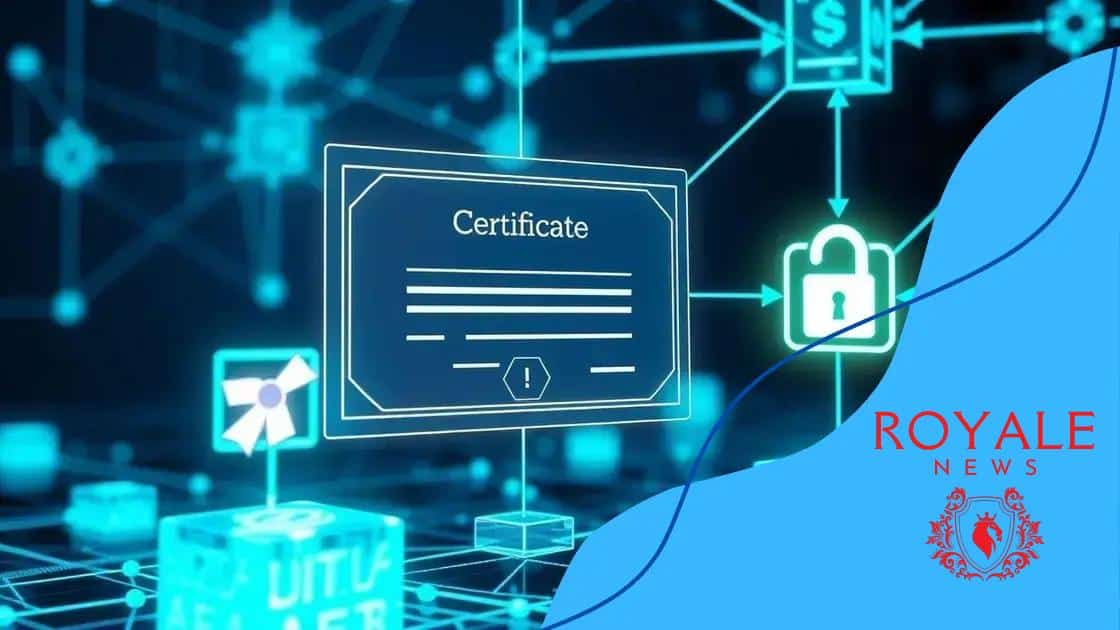Blockchain for secure academic credentials: a game changer

Blockchain for secure academic credentials enhances verification accuracy and security, allowing institutions to issue tamper-proof diplomas while ensuring real-time access for employers.
Blockchain for secure academic credentials is transforming how we verify qualifications. Imagine a world where diplomas can’t be forged and employers trust the authenticity of your achievements. Let’s explore how this technology is reshaping the educational landscape.
Understanding blockchain technology
The concept of blockchain technology can seem complex, but it’s actually quite simple. At its core, it is a distributed digital ledger that records transactions across many computers. This technology ensures that every transaction is verified and immutable, meaning it cannot be changed or deleted. The security of blockchain comes from its decentralized nature, creating a secure environment for data.
How Blockchain Works
Blockchain operates through a network of computers, known as nodes. Each node contains a copy of the entire blockchain. When a transaction occurs, it is grouped with others into a block. After being verified by the network, this block gets added to the blockchain. This process is quick and transparent, making it easy to track changes.
Key Features of Blockchain Technology
- Decentralization: No single entity controls the blockchain.
- Transparency: All transactions are visible to anyone with access.
- Security: Uses cryptographic techniques to protect data.
- Immutability: Once recorded, data cannot be altered without consensus.
This radically changes how we think about trust and verification. For example, with blockchain, academic credentials can be verified quickly and securely without the need for a central authority. This technology not only enhances privacy but also simplifies the process of authentication.
As more institutions adopt blockchain technology, understanding its implications becomes essential. It bridges gaps between education and technological advancements, ensuring that credentials remain secure and trustworthy.
Benefits of blockchain in education
The benefits of blockchain in education are significant and transformative. By utilizing this technology, educational institutions can enhance the verification of credentials, making the entire process more efficient. This leads to increased trust among employers and organizations that rely on accurate academic records.
Increased Security
One of the primary advantages of utilizing blockchain is its enhanced security. Each record is encrypted and linked to previous transactions, making it nearly impossible to alter information without detection. This crucial feature reduces the risk of fraud and ensures the integrity of academic achievements.
Streamlined Verification Process
Blockchain simplifies the verification process for qualifications. By providing a decentralized ledger, employers can quickly verify a candidate’s academic records without contacting the institution directly. This saves time and resources for all parties involved.
- Efficient Record-Keeping: Institutions can maintain a permanent record of all credentials.
- Reduced Costs: Fewer administrative resources are needed for verification.
- Instant Access: Students can share their credentials easily with potential employers.
- Interoperability: Different institutions can access and verify each other’s data easily.
Moreover, blockchain technology promotes greater transparency. With all records being public within a network, stakeholders can easily track and audit academic histories. This open approach fosters accountability, leading to higher standards within educational systems.
As we explore these benefits further, we see that blockchain also facilitates greater student control over their data. Students can manage their academic records securely and decide who can access them. This autonomy is empowering and enhances the overall educational experience.
How blockchain enhances credential verification

Understanding how blockchain enhances credential verification is essential in today’s digital age. This technology revolutionizes how academic achievements are confirmed. By utilizing a decentralized system, it creates an efficient and trustworthy method of ensuring that information is accurate and tamper-proof.
Real-Time Verification
One significant advantage of blockchain is its ability to facilitate real-time verification. When a student receives a diploma, it is immediately recorded on the blockchain. This means potential employers can check credentials instantly, removing the need for lengthy background checks.
Enhanced Accuracy and Trust
The immutable nature of blockchain technology ensures that once data is entered, it cannot be altered. This leads to increased trust between educational institutions and employers. With a transparent record, both parties can verify achievements without fear of manipulation or fraud.
- Streamlined Process: Automated systems reduce the time needed for verification.
- Direct Control: Students can manage their credentials without institutional middlemen.
- Global Accessibility: Employers worldwide can access verified records from anywhere.
- Integration with Other Technologies: Blockchain can work seamlessly with AI tools for further verification.
This new approach not only saves time but also builds a more reputable educational environment. Institutions embracing blockchain are often seen as innovative and forward-thinking. This positive perception enhances their appeal to prospective students.
As the demand for secure and quick credential verification grows, blockchain technology stands out as a solution. It transforms potential barriers into bridges, fostering collaboration between educational entities and employers in a globalized job market.
Real-world examples of blockchain in academia
Exploring real-world examples of blockchain in academia illustrates how this technology is being used to enhance educational processes today. Many institutions are already leveraging blockchain to improve record-keeping and verification systems, which benefits students, employers, and schools alike.
MIT Media Lab
The MIT Media Lab has implemented a blockchain-based system for issuing digital diplomas. This initiative allows graduates to share their credentials with employers easily. Each diploma is recorded on the blockchain, ensuring that the information is secure and verifiable. This innovative solution not only saves time but also enhances the credibility of the certificates issued.
University of Nicosia
The University of Nicosia, located in Cyprus, was among the first institutions to accept Bitcoin as payment for tuition fees. It has also introduced blockchain technology for verifying academic records. Students can access their diplomas and transcripts through a secure blockchain system, securing their personal data while ensuring authenticity.
- Blockchain in Higher Education: Universities are working on using blockchain to track student progress and course completions.
- Online Education Platforms: Some platforms are offering blockchain certificates for course completions, verifying skills and knowledge acquired.
- Partnerships with Businesses: Institutions partner with companies to create blockchain projects, preparing students for future job requirements.
- Global Reach: Blockchain allows institutions to connect students with employers worldwide without geographical restrictions.
Other universities have also started to explore partnerships with blockchain firms to stay ahead of the curve. They are using the technology to create digital identities for students, enabling them to manage their learning paths effectively and securely.
By examining these examples, we can see the transformative potential of blockchain technology in education. It not only streamlines processes but also builds trust between educational institutions and employers through verifiable achievements.
Challenges of implementing blockchain systems
Implementing blockchain systems in education comes with its own set of challenges. While the benefits are significant, several obstacles can hinder the adoption and effective use of this technology.
Technical Complexity
One major challenge is the technical complexity associated with establishing a blockchain infrastructure. Many educational institutions may lack the necessary expertise to implement and maintain such systems. Training staff or hiring new personnel can lead to increased costs.
Integration with Existing Systems
Integrating blockchain with existing administrative systems poses another hurdle. Many institutions already utilize various software platforms for managing records. Ensuring seamless interaction between new blockchain solutions and current systems can be difficult, often requiring extensive modifications.
- Data Privacy Concerns: As blockchain is inherently transparent, balancing privacy while maintaining security can be challenging.
- Regulatory Issues: Navigating legal regulations related to data and digital transactions can complicate implementation.
- Resistance to Change: Faculty and administration may resist adopting new technologies, preferring familiar processes.
- Initial Costs: The upfront investment for blockchain technology can be substantial, posing a barrier for some institutions.
In addition to these challenges, there is also the issue of ensuring stakeholder buy-in. Gaining support from faculty, students, and administrative staff is essential for successful implementation. Without widespread acceptance, even the most technically sound solutions may fail.
Furthermore, the rapidly evolving nature of blockchain technology means that institutions must continuously update their systems and processes to stay current. This ongoing need for adaptation can strain resources and pose additional challenges.
In conclusion, exploring the impacts of blockchain technology in education shows great promise. While it offers significant benefits like enhanced security, real-time verification, and greater accessibility, there are also challenges to consider. Institutions must navigate technical complexities and foster acceptance among stakeholders. Overall, with careful planning and implementation, blockchain has the potential to transform the educational landscape for the better.
FAQ – Frequently Asked Questions about Blockchain in Education
What are the main benefits of using blockchain in education?
The main benefits include enhanced security, real-time verification of credentials, and greater accessibility for students and employers.
What challenges do institutions face when implementing blockchain systems?
Institutions may encounter technical complexity, integration with existing systems, and resistance to change among staff and faculty.
How can blockchain technology improve the verification process for academic credentials?
Blockchain provides a secure and transparent method for verifying credentials, allowing employers to confirm a candidate’s achievements quickly.
Are there real-world examples of blockchain being used in education?
Yes, many institutions, like MIT and the University of Nicosia, are using blockchain to issue digital diplomas and manage academic records securely.





